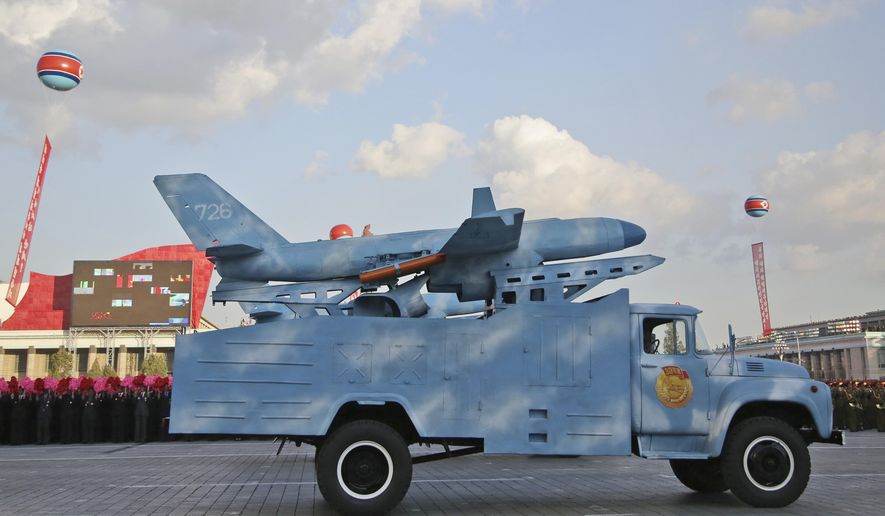North Korea’s military has 300 to 400 attack drones capable of carrying biological and chemical weapons that could reach the South Korean capital of Seoul within one hour, according to a high-level defector from the isolated regime ruling Pyongyang.
The claim from a 42-year-old former third secretary who fled Kim Jong-un’s regime in 2015 coincides with heightened international concern over a different threat from North Korea: mobile, medium- to long-range missiles that Pyongyang has tested with increasing frequency.
After successfully launching one of the solid-fuel missiles Sunday, North Korean leaders said they are ready to begin deploying and mass-producing the Pukgukson-2 projectiles, which Pyongyang says are capable of reaching major U.S. military bases in Japan.
The Sunday launch was the latest of more than 70 North Korean missile tests since 2009, resulting in a U.S. and regional focus on countering the ballistic missiles.
An equally urgent drone threat may be emanating from Pyongyang, according to an interview with an individual using the alias Jin-myeong Han that the Sekai Nippo newspaper in Japan published last week.
North Korea has been running a clandestine program since the late 1990s that includes preparations to mount biological and chemical weapons on drones for aerial attacks, according to Mr. Han, whom Sekai Nippo described as a former third secretary once stationed in Vietnam.
The newspaper also described Mr. Han has having begun his career in the North Korean air force and having once been involved in managing the regime’s drone activities.
“My guess is that it has 300 to 400 drones,” Mr. Han said, adding that the drones are stored underground because U.S. and other reconnaissance satellites are “intensively conducting surveillance” near the Demilitarized Zone that separates the Koreas.
The drones often are moved to different sites and “are in the stage of battle deployment in term[s] of technology,” he said. “In an emergency situation, drones can reach Seoul airspace in about one hour.”
Pyongyang’s drone fleet has been known for some time. Speculation surged in 2014 when three North Korean drones crashed in South Korean territory. Military officials in Seoul said the unmanned vehicles were mounted with cameras and were believed to be surveillance drones.
Mr. Han said the South Korean military may have a system that uses electronic jamming to prevent drone incursions from the North, but he maintained that Pyongyang is capable of flying the vehicles at low altitudes to avoid detection by radars such as the Terminal High Altitude Area Defense (THAAD) system that the U.S. recently deployed to the South.
He said he was assigned during the late 1990s to an air force facility in North Korea’s North Pyongan province, where he worked on radio communication for attack drones.
“I was surprised to see that people from the Korean Workers’ Party came and mounted something that appeared to be biological and chemical weapons on the drones,” said Mr. Han. “They conducted an experiment to spray chemical or biological agents over the mountains and fields nearby. I went to the mountain afterward to check and found all animals dead, although plants survived.
“Information about the specific type of agents was kept secret,” said Mr. Han, asserting that the North has since developed a process in which “a 1,200-liter tank is mounted on the drone, and it can carry biological and chemical weapons in the tank.”
The specter of such threats hung in the backdrop Monday as world powers scrambled to respond to North Korea’s latest missile test and Pyongyang’s vow to begin mass producing the Pukgukson-2.
The weapon is a land-based version of a submarine-launched missile, and its successful test advances North Korea’s weapons capabilities because solid-fuel missiles can be fired faster and more secretly than those using liquid fuel, which must be added separately and transported to launch sites with trucks that can be seen by satellites.
U.S. officials said the Pukgukson-2 traveled more than 300 miles toward the Japanese coast and reached a height of nearly 350 miles on Sunday before crashing into the East Sea/Sea of Japan.
Kim Jong-un ordered the launch and watched from an observation post, according to state media reports, which cited the North Korean leader as saying he had “approved the deployment of this weapon system for action” and that it should “be rapidly mass-produced.”
The missile is seen to pose the greatest threat to South Korea and Japan and the 80,000 U.S. troops positioned in the two nations.
At the United Nations, French diplomats on Monday called for the Security Council to level more sanctions against Pyongyang.
Analysts say the success of the sanctions effort will depend on more serious buy-in from China.
The Trump administration has spent recent months pushing a policy that was initially set into motion by the Obama administration of trying to pressure China to apply sanctions and influence Pyongyang toward halting its missile and nuclear tests.
• Carlo Muñoz contributed to this article, which is based in part on wire service reports.
• Guy Taylor can be reached at gtaylor@washingtontimes.com.




Please read our comment policy before commenting.